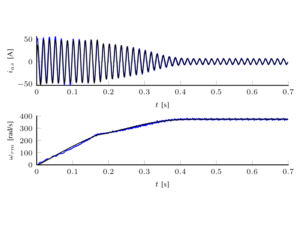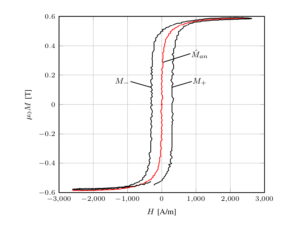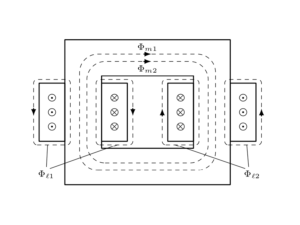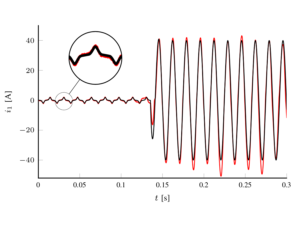Projects & Grants





Power Electronics and Controls
- Cale’s research group led the development of a power-electronic testbed and new control methodologies to support the electrification of aircraft. As part of this research, a power converter and aeroactuation testbed was designed and built at the CSU Powerhouse Energy Campus (see below). The original version of the testbed emulates electromagnetic thrust reverse actuation system (EM-TRAS). Cale’s group developed new control strategies, control optimizations, and hardware realizations to achieve central-converter multi-motor control EM-TRAS. This research was funded by Woodward and was performed in collaboration with Woodward and the Institut National des Sciences Appliquées (INSA) in Toulouse, France. ,

- Cale’s group has led projects to design and evaluate controls for hybrid generation systems that include battery energy storage in parallel with traditional generators to reduce emissions, fuel usage, and improve transient response. This work was funded by Moser Energy Systems.
- Cale’s group, in partnership with NREL and LBNL developed a mathematical framework and Modelica modeling toolkit for evaluating the potential advantages of DC distribution in buildings with a high proportion of power-electronic devices (e.g., plug-loads). This work, funded by the DOE BENEFIT program, has resulted in a new open-source software toolkit, Building Energy Efficiency Analysis Model (BEEAM).
- Cale was awarded an internally-competitive research grant at NREL to develop a novel feedback control strategy for mitigating communication delays in remote hardware-in-loop (HIL) systems. This methodology was verified experimentally between two systems running at CSU and NREL (approximately 100 km away).
Selected Publications:
C. Lima and Cale, J., “Control design for position synchronization in central converter multi-machine actuators,” in Proc. of the International Conference on Electrical, Computer, Communications and Mechatronics Engineering (ICECCME 2023), Tenerife, Spain, July 19–21, 2023.
A. Othee, Cale, J., A. Santos, S. Frank, D. Zimmerle, O. Ghatpande, G. Duggan, and D. Gerber, “A modeling toolkit for comparing AC versus DC electrical distribution efficiency in buildings,” Energies 2023, 16(7), Mar., 2023.
C. Lima, Z. Miller, A. Riley, Cale, J., and et al., “A novel electromechanical actuation testbed for emulation of aerospace actuation systems,” in Proc. of the 33rd Aerospace Testing Seminar, El Segundo, CA (USA), May 15, 2023.
C. Lute, J. Cale, Ross, G., D. Moorman, and M. Dorflinger, “Evaluating power and environ- mental performance in mobile microgrid generator systems,” International Journal of Electrical Power and Energy Systems, vol. 121, Oct. 2021.
J. Cale, E. Dall’Anese, B. Johnson, P. Young, G. Duggan, P. Bedge, D. Zimmerle, and L. Holton, “Mitigating communication delays in remotely connected hardware in the loop experiments,” IEEE Transactions on Industrial Electronics, vol. 65, no. 12, pp. 9739–9748, 2018.
Magnetics
- Cale led a research project that developed a novel computational and experimental procedure for in situ characterization of nonlinear magnetization in transformers and parameter extraction of electrically non-symmetric and unbalanced capacitor-start induction machines. This research was funded by Factor[e] Ventures.
- Cale is also developing a magnetic material characterization laboratory at Powerhouse. He served as faculty of a senior ECE undergraduate project to develop a testbed and graphical user interface for automated extraction of the nonlinear permeability and frequency-dependent coercivity of ferromagnetic materials. More about the project can be found here.
Selected Publications:
J. Cale, C. Lute, J. Simon and A. Delcore, “Modeling Minimally-Processed Shielded Metal Arc Weld Transformers for Rural Minigrid Applications,” IEEE Power and Energy Technology Systems Journal, vol. 6, no. 2, pp. 95-103, June 2019.
J. Cale, C. Lute, G. Ross, and A. Othee, “Characterization procedure for unsymmetrical split-phase capacitor-start induction machines,” IEEE Power and Energy Technology Systems Journal, 2020, vol. 8, Oct. 2020.
Microgrids and Energy Access
- Research in microgrids and energy access in the Cale research group has included modeling, simulation and validation of microgrid generation, control technologies, and loads. Funded research has included:
- Energy Access: modeling and characterization of highly-inductive loads found in rural minigrids, evaluation of solar pump efficiency, and development of a microgrid controller testbed. This work included at-power evaluation at the CSU Powerhouse Energy Campus (see publications below).
- Hybrid Microgrids: research in hybrid microgrids has included the assessment of power quality metrics and emissions for hybrid mobile microgrid generators, which include a combination of battery energy storage with natural gas generators under uncertain loads.
- In addition, Cale’s group is developing the Rapid Microgrid Control Development Testbed (RMCDT), a bench-top hardware platform for emulating three-phase microgrids in both grid-connected and islanded mode. The RMCDT includes power converters for controllable grid simulation, solar, energy storage, electrical motors, and controllable loads [more details soon].
Selected Publications:
C. Lute, J. Cale, Ross, G., D. Moorman, and M. Dorflinger, “Evaluating power and environmental performance in mobile microgrid generator systems,” International Journal of Electrical Power and Energy Systems, vol. 121, Oct. 2021.
J. Cale, C. Lute, G. Ross, and A. Othee, “Characterization procedure for unsymmetrical split-phase capacitor-start induction machines,” IEEE Power and Energy Technology Systems Journal, 2020, vol. 8, Oct. 2020.
J. Cale, C. Lute, J. Simon and A. Delcore, “Modeling Minimally-Processed Shielded Metal Arc Weld Transformers for Rural Minigrid Applications,” IEEE Power and Energy Technology Systems Journal, vol. 6, no. 2, pp. 95-103, June 2019.
C. Lute, T. Decker, J. Cale and A. Delcore, “A Method for Evaluating Unregulated Solar Irrigation Pumping Systems: Results and Observations,” 2019 IEEE Global Humanitarian Technology Conference (GHTC), Seattle, WA, USA, 2019, pp. 1-8.
Machine Learning
Research in machine learning has included a pattern recognition approach for enhancing the reliability and lifecycle maintainability of battery energy storage systems from a fleet perspective. This research includes the synthesis of numerical classification technology with finite queuing system optimization.
Cale developed a computational approach for applying principal components analysis (PCA) and k-mediod clustering for classifying types of distribution feeders on an electrical distribution system; this research was funded under the DOE SunShot program.
Selected Publications:
R. Pirani and J. Cale, “Comparison of pattern recognition approaches for identification of failure-prone battery cells,” in Proceedings of the 2022 International Systems Engineering Conference (SysCON), 2022, Montreal, Canada, 2022, pp. 1–8.
Pirani, R. and Cale, J., “A pattern recognition approach for enhancing lifecycle maintain- ability of battery systems,” in 2019 International Symposium on Systems Engineering (ISSE), 2019, Edinburgh, Scotland, 2019, pp. 1–8.
Cale, J., B. Palmintier, D. Narang, and K. Carroll, “Clustering distribution feeders in the Arizona Public Service territory,” in Proceedings of the 40th IEEE Photovoltaic Specialist Conference (PVSC), 2014, Denver, Colorado (USA), 2014, pp. 2076–2081.
Stochastic Variability Modeling and Optimization
- Funded research by NREL includes modeling and characterization of stochastic load variability found in modern buildings, which will ultimately be used to model and enhance energy flexibility.
- Cale’s group is currently developing a new stochastic optimization approach for risk-constrained optimization for wind-based microgrids [more details soon].
